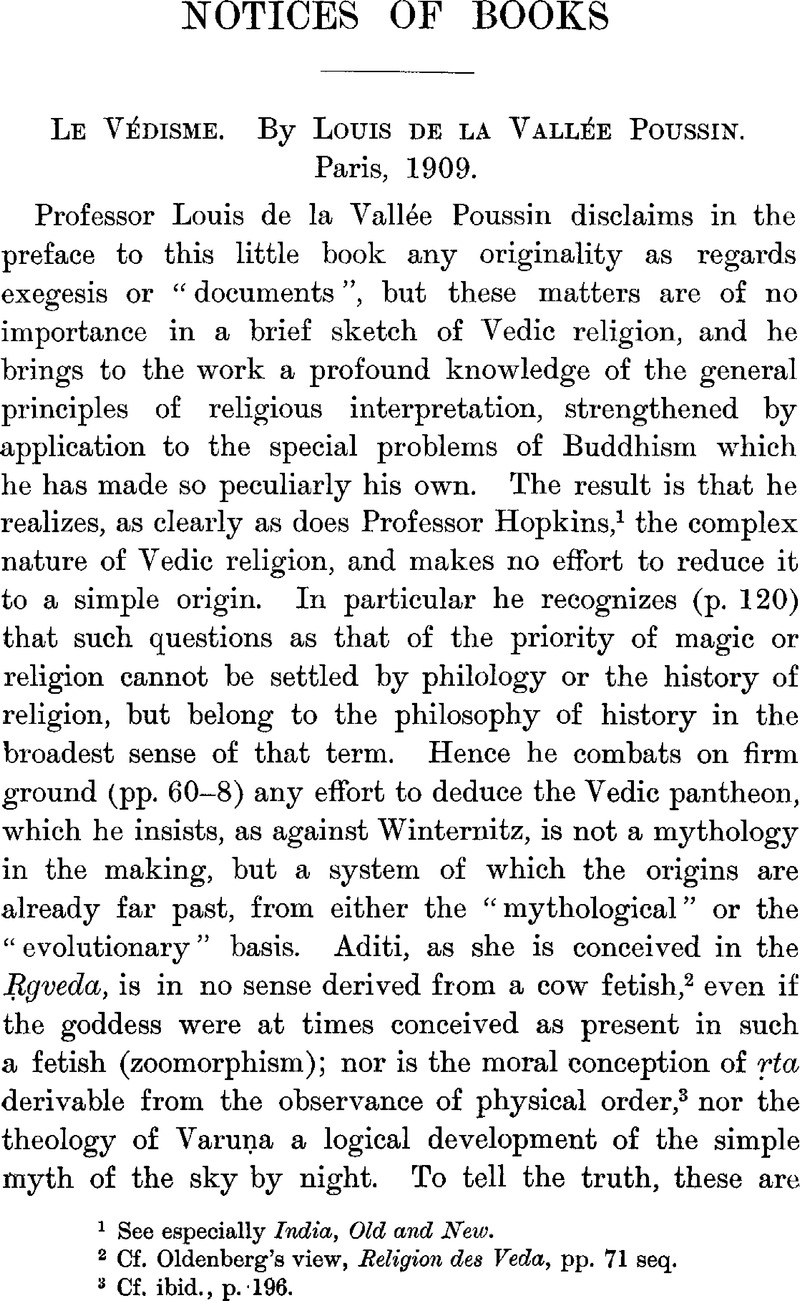No CrossRef data available.
Article contents
Le Védisme. By Louis de la Vallée Poussin. Paris, 1909.
Review products
Published online by Cambridge University Press: 15 March 2011
Abstract

- Type
- Notices of Books
- Information
- Copyright
- Copyright © The Royal Asiatic Society 1909
References
page 469 note 1 See especially India, Old and New.
page 469 note 2 Cf. Oldenberg's view, Religion des Veda, pp. 71Google Scholar seq.
page 469 note 3 Cf. ibid., p. 196.
page 470 note 1 The terminology of writers on religion is very confusing. By fetishism I mean the respect paid to some object, or animal, or man, because the deity is—usually temporarily, and always only in part—present therein, e.g. as in the wheel worship of the sun, see JRAS., 1908, p. 1098,Google Scholar or in baetyl worship, Conybeare, , Trans. Third Inter. Congr. Hist. Rel., ii, 177Google Scholar seq. Theriomorphism (e.g. Indra as a bull) may be merely “mythological”, but tends to fetishism. Zoolatry and chrematheism should perhaps be reserved to describe the worship of “natural forces”, including animals, as directly and per se divine, a view older than “animism” in Tylor's sense (cf. Marett, , Threshold of Religion, Trans. Third Inter. Congr. Hist. Rel., i, 46;Google Scholar Clodd, ibid., i, 23), which develops into the anthropomorphism or theriomorphism seen in the Ṛgveda, in which, however, moral conceptions are intricately blended. Totemism, which Poussin does not find in the Ṛgveda, implies at any rate, besides worship, a belief in a bond of blood with the divinity, and a social system based on that belief. It is very possibly a back path of religion, not primitive;cf. Toutain, ibid., ii, 121. A counterpart of zoolatry and chrematheism is demonolatry (cf. Farnell, , Evolution of Religion,Google Scholar ch. iii), while abstract deities are present in the oldest religions we have. It may be added that Hopkins (Religions of India, p. 135Google Scholar), who distinguishes chrematheism and pantheism and fetishism, regards some of the ritual veneration and, no doubt in part rightly, the non-ritual veneration of the drum, etc., as chrematheism. Gomperz (Greek Thinkers, i, 522, 523Google Scholar) keeps the older use of fetishism as equivalent to chrematheism.
page 470 note 2 Hopkins, , op. cit., p. 95.Google Scholar
page 470 note 3 Cf. Murray, , Rise of the Greek Epic, pp. 148Google Scholar seq.
page 471 note 1 Making of Religion (1898);Google Scholar cf. Hartland, , Trans. Third Inter. Congr. Hist. Rel., i. 21Google Scholar seq.
page 471 note 2 Cf. JRAS., 1909, p. 209.Google Scholar
page 471 note 3 Les Castes dans l'Inde, pp. 207Google Scholar seq. Cf. Fick, , Die sociale Gliederung, p. 3,Google Scholar n.; Oldenberg, , ZDMG., li, 267Google Scholar seq.
page 471 note 4 Livy, , xxxix, 19, 5;Google Scholar cf. Mommsen, , Röm. Forsch., i, 10;Google ScholarSmith, , Dict. of Ant., ii, 139.Google Scholar
page 472 note 1 Smith, , Dict. of Ant., i, 940;Google Scholar ii, 134; Gilbert, , Greek Constitutional Antiquities, pp. 186Google Scholar seq.
page 472 note 2 Cf. Weber, , Ind. Stud., x, 73Google Scholar seq.
page 472 note 3 Davids, Rhys, Buddhist India, p. 57;Google Scholar Fick, pp. 34 seq.
page 472 note 4 See Jolly, , Recht und Sitte, pp. 61Google Scholar seq. The age of the practice cannot be proved by Sūtra evidence.
page 472 note 5 Case of Yama, and Yamī, , Ṛgveda, x, 10.Google Scholar Von Schroeder's view (Mysterium und Mimus, pp. 275Google Scholar seq.) seems to me unnatural. Cf. also for the Iranian usage, Moulton, , Trans. Third Inter. Congr. Hist. Rel., ii, 94.Google Scholar
page 472 note 6 Murray, , Rise of the Greek Epic, pp. 117Google Scholar seq.
page 472 note 7 Vedische Studien, ii, 218Google Scholar seq.
page 473 note 1 Vedische Mythologie, i, 105Google Scholar seq., repeated in Trans. Third Inter. Congr. Hist. Rel., ii, 15Google Scholar seq.; endorsed by Grierson, , JRAS., 1908, pp. 604Google Scholar seq.
page 473 note 2 Cf. Lindsay, , Latin Language, p. 2.Google Scholar
page 473 note 3 JRAS., 1908, p. 884.Google Scholar
page 473 note 4 On p. 59, n. 1, the reference should be JRAS., 1907, pp. 929Google Scholar seq.


